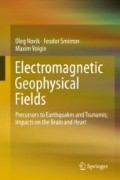Abstract
In this chapter, we briefly describe the structure and dynamics of the plasma of the solar wind, which supplies solar energy to the plasmas of the earth’s geospheres, namely the magnetosphere and ionosphere. Then, geomagnetic storms, which develop there and disturb the physical fields of the underlying earth atmosphere, are discussed. We use the qualitative approach of the US Space Weather Prediction Center (SWPC), the National Oceanic and Atmospheric Administration (NOAA), Spacepedia, Wikipedia, and the National Aeronautic and Space Administration (NASA) to discuss these subjects, i.e., systems of partial differential equations (PDEs; e.g., ones describing magneto-hydrodynamics) are not applied in this chapter, though the processes described by them include most of the related physics. (We note that systems of PDEs are applied and/or investigated by us numerically and mathematically in Chaps. 1, 2, 3, 9, 10, and 11 of this book.)
The influences of geomagnetic storms (estimated by the planetary geomagnetic index Kp, which is described in this chapter) on the human brain and heart are considered in Chaps. 5, 6, 7, and 8 of this book.
Access this chapter
Tax calculation will be finalised at checkout
Purchases are for personal use only
References
Abdu, M. A., et al. (Eds.). (2011). Aeronomy of the earth’s atmosphere and ionosphere. New York: Springer.
Bartels, J. (1939). The three-hour range index measuring geomagnetic activity. Geophysical Research, 44, 411–454.
Buchkov, V., et al. (Eds.). (2014). The atmosphere and ionosphere. New York: Springer.
Campbell, W. (2003). Introduction to geomagnetic fields (2nd ed.). Cambridge: Cambridge University Press.
Delamere, P., et al. (Eds.). (2015). Solar wind interactions with giant magnetospheres and earth’s magnetosphere, Geophysical monograph series. Washington, DC: American Geophysical Union.
Gonzales, W. D., et al. (1994). What is a geomagnetic storm. Journal of Geophysical Research, 99(A4), 5771–5792.
Liu, W., & Fujimoto, M. (2011). The Dynamic Magnetosphere. Springer.
Meyer-Vernet, N. (Ed.). (2007). Basics of solar wind, Cambridge atmospheric and space science series (p. 478). Cambridge University Press: Cambridge.
Miralles, P. M., & Almeda, J. S. (2011). The Sun, the solar wind, and the heliosphere. New York: Springer.
Waltz, K. (2015). Solar wind (p. 216). New York: Callisto Reference.
Author information
Authors and Affiliations
Rights and permissions
Copyright information
© 2019 Springer Nature Switzerland AG
About this chapter
Cite this chapter
Novik, O., Smirnov, F., Volgin, M. (2019). Space Weather. In: Electromagnetic Geophysical Fields. Springer, Cham. https://doi.org/10.1007/978-3-319-98461-2_4
Download citation
DOI: https://doi.org/10.1007/978-3-319-98461-2_4
Published:
Publisher Name: Springer, Cham
Print ISBN: 978-3-319-98460-5
Online ISBN: 978-3-319-98461-2
eBook Packages: Earth and Environmental ScienceEarth and Environmental Science (R0)

